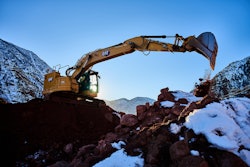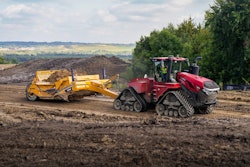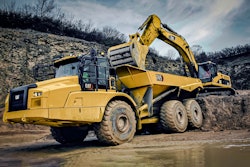“I don’t think we’re going to see a recession in the next year or longer,” says Ken Simonson, chief economist for the Associated General Contractor of America.
On this episode of The Dirt, Simonson explains his brighter outlook than what contractors might have been hearing. He points to a variety of tailwinds that are pushing the overall construction industry away from a major downturn and will likely lead to an acceleration in business after next year.
He also gives his take on inflation, the labor shortage and interest rates, and explains what’s going on with diesel prices and when relief might come.
His interview with host Bryan Furnace is a must-view for anyone in the construction industry concerned about the future and what moves they should be considering now.
So check out the latest episode of The Dirt to see what you can expect in 2023 and beyond.
Equipment World serves up weekly videos on the latest in construction equipment, work trucks and pickup trucks – everything contractors need to get their work done. Subscribe and visit us at equipmentworld.com!
In this episode
00:00 - Intro: Economic Update and 2023 Outlook
00:43 - What Is Currently Happening in the Economy?
02:42 - The Construction Economy Will Only Be Improving
04:05 - Construction Concerns for 2023
05:50 - Why Are Diesel Prices So High and When Will They Go Down?
09:35 - Tips for Contractors in 2023
11:15 - How Long Will the Current Economic Downturn Last?
13:00 - Wrap Up: The 2023 Economy Won’t Be That Bad
Video transcript
Bryan Furnace (00:00):
Hi everybody. Welcome back to Equipment World. You're watching The Dirt. I'm your host Bryan, and today we're here for another economic update. We've had the war in Ukraine, we've had a semi-recession, we've got the crazy labor dynamic, we've got crazy diesel prices. It's been a little bit of a year for all of us and so I figured it would be nice to recenter with Ken Simonson, our kind of unofficial resident economist here. It's been his third time on the show, I believe. We're going to circle back with Ken and get a quick update on where we're at from an economic standpoint and what we can kind of expect over the next six to 12 months.
(00:43):
So my first question is just could we get a broad overview of what's been going on with the economy and kind of where we're at on the excavating side of the industry?
Ken Simonson (00:53):
As for the overall economy, I know there's a lot of pessimism out there, an assumption that we're either in a recession or about to fall into one. Well, I admit to being a perpetual optimist, and I don't think we're going to see a recession in the next year, or longer. First of all, we're continuing to get very strong job growth. That is likely to taper off. We've sure heard some big announcements of layoffs at firms that we're formally eagerly hiring. But nevertheless, the economy is a lot broader than the few companies that have made headlines. And most firms, I think, are still doing well in terms of sales and hiring. Certainly job openings have remained at extraordinarily high levels. So if people are willing to change locations, perhaps change careers, there's still going to be openings for them.
(01:41):
And as for inflation, that's certainly a concern, and it does look like the Fed is going to keep raising interest rates, which will put a squeeze on certain businesses, but I think inflation is headed down. Probably not as low as the Fed wants to get it, and so we will still see those interest rates going up, but again, it's not going to push us into recession. There's a lot of spending power among individuals, businesses, and certainly all levels of government.
(02:08):
So all of those things have implications for construction. Some are negative. The rise in interest rates has already been pretty devastating for home building and I think it's going to take a toll on any kind of income producing property, whether it's apartments, retail, warehouse, office, hotel construction. However, there are also large markets that aren't dependent very much on interest rates. I'm thinking about infrastructure, power plants or alternative power sources, and manufacturing. And all of those are poised for very strong growth or are already experiencing it.
Bryan Furnace (02:42):
It is interesting because that is exactly what I'm seeing anecdotally in the field. We've started to hear from contractors that are more on the residential side of the market or are doing, like you said, apartments, income generating buildings. And there's definitely been a taper off in that sort of development, but at the same time, when it comes to anything else in the market right now construction wise, it seems like it hasn't even faltered in its step. It's just continuing to boom it feels like.
Ken Simonson (03:08):
Yeah, in fact, I think things are going to get even better. Remember the Infrastructure Investment and Jobs Act passed in November of 2021 and that promised a trillion dollars worth of investment over several years. That money has been awarded to some degree, but it hasn't really hit the ground in terms of contractors going out and starting to dig. And I think you're going to see that early in 2023 and just continuing on from there.
(03:38):
We've also had huge number of announcements of manufacturing plants. Some of them are already underway, these incredibly expensive semiconductor fabrication or fab plants and a few of the auto plants, but there seem to be a lot more electric vehicle and battery plants and other components for cars, but also new forms of manufacturing to support alternative energy, battery charging stations, and a lot else.
Bryan Furnace (04:05):
I would like your opinion on something, just kind of your off the cuff thoughts. We're in kind of a weird time in the construction industry because there are components that are playing into the economy that you would think would slow down the industry to an extent. But at the same time, we're dealing with this really short labor market and we're dealing with this huge backlog of work that's been generated. And like you mentioned, we have all of this new money coming in from the infrastructure bill. Are these things kind of competing with each other to either pull the needle up or move the needle down or kind of how are these dynamics impacting each other?
Ken Simonson (04:35):
Well, I do expect a lot of churn. I think already, and going forward, labor supply is going to be the number one concern for a lot of contractors. For two years the concerns were the cost of materials constantly going up or the cost of diesel fuel and then also the supply chain. Well, bits of the supply chain have gotten a lot better. Unfortunately, some other things have gotten worse. Anybody who's trying to get a truckload of concrete or precast concrete-
Bryan Furnace (05:03):
It's terrible right now.
Ken Simonson (05:05):
Yeah. Or if you want to get something hooked up to the local utility, they may be saying, "Sorry, we're keeping our few transformers for the next emergency." There are certainly some big supply chain challenges, but in terms of the longer run, I mean those things should work out over time. But labor is going to be a continuing issue. As more people retire, we have smaller cohorts of people moving up into the working age categories, and we've really ratcheted down immigration, which historically was a big source of workers for construction. So we'll see some rotation, if you will. Some people who had been working on single family homes would be able to move over to some segments of construction, but they won't necessarily have the skills for the jobs that are most needed.
Bryan Furnace (05:51):
So my next question for you. We have a portion of the population that thinks that Biden is solely responsible for diesel prices. And we have another portion of the population that thinks that solely the oil companies are responsible for diesel prices. As the actual economist in the room, could you kind of give us an idea of what's really going on behind the scenes of diesel prices? And then when can we expect, if ever, some relief from the diesel prices we've been seeing recently?
(07:29):
Could you kind of give us an idea of what's really going on behind the scenes of diesel prices, and then when can we expect, if ever., some relief from the diesel prices we've been seeing recently?
Ken Simonson (07:39):
Well, I think I can answer the first part, the second …
Bryan Furnace (07:43):
Total roll of the dice on the second one?
Ken Simonson (07:45):
Well, that's right. I've been a business economist for over 50 years, and I don't think I've ever gotten diesel prices right more than half the time.
Bryan Furnace (07:54):
Fair enough.
Ken Simonson (07:54):
You may as well roll those dice, but.
Bryan Furnace (07:56):
We won't hold it against you.
Ken Simonson (07:58):
All right. Well I do think that the situation with diesel is really global, and the President shouldn't get credit or blame for most of what's going on. Clearly, Russia's attack on Ukraine, the shutdown of pipelines there, and countermeasures by the West have caused huge turmoil in the markets for crude oil, for diesel fuel, and for natural gas, and these are all interrelated, particularly the crude oil and diesel fuel. With the global demand for crude oil and for diesel rising, but a significant source of supply being cut off, naturally prices are going up and oil and petroleum products are global markets. So the US is feeling those impacts quite strongly.
(08:44):
We've also lost some refining capacity over the last couple of years, that some unprofitable refineries have shut down, and that means we're producing less diesel fuel than we used used to at a time when the economy is growing. Trucks are back on the road; a lot more off-road equipment is gunning its engines. So to get to the prediction part, I think we'll continue to see fluctuations as we have in the last few months, but certainly not a return to those crude oil prices down in the 60s and diesel prices down in the sub $3 range. We'll be lucky if we get it below $5, unfortunately.
Bryan Furnace (09:21):
Oh, boy. So start ratcheting up your diesel surcharge a little bit because we're in this for the long haul.
Ken Simonson (09:26):
Well, I never tell people what to do on their pricing, but yeah, you're going to have the cost, so you've got to cover them somehow.
Bryan Furnace (09:33):
Absolutely. So any tips for contractors as we kind of move through? You summed it up Well in the beginning. We're in this tumultuous tribulation period and everyone's very pessimistic. I'm with you. Everyone's, "We're definitely headed to a recession, definitely headed to recession." And I think it's more of the mental game at this point for a lot of contractors than it is the actual what's happening with the economy. In this weird time, any tips that you can think of for contractors just as they're thinking about, "Do I really want to go finance that next piece of equipment? Do I want to go stretch myself for that next job?"
Ken Simonson (10:06):
My first piece of advice would be aware. Know that things are changing, sometimes quite rapidly or quite drastically. I mean, the drop off in new home construction is certainly pretty dramatic. It hasn't yet hit those income producing properties very much, but they're very much at risk because as those financing costs keep going up and construction costs keep going up, and at the same time the economy is weakening, developers are going to say, "Hey, wait a minute. I can't keep raising rents in this kind of market to cover these costs." So they're going to pull the plug on projects that haven't broken ground yet.
(10:42):
Keep an eye out on what's happening on the infrastructure side. State and local governments have a lot of money, not just from the federal government but from their own sources, whether it's a state income tax, a local property tax that reflects that run up in house prices over the last several years means that school districts and public agencies may be doing a lot more construction. So there's certainly opportunities, but don't expect them to be in the same places that you've been working in the last couple of years, either by market segment or necessarily geographic.
Bryan Furnace (11:14):
Great advice. I'm going to have you gaze into your crystal ball one more time for me. How long do you think we're kind of in this weird downturn? Any feel for is this going to be something that's kind of a long-drawn-out thing, like going back to kind of '07 to where it's just going to kind of be a long slow burn? Or is this something that's more of a hiccup in your mind?
Ken Simonson (11:32):
Well, I think the economy is a lot healthier than it was in 2007. We had huge amount of over lending, overbuilding of single-family homes being purchased by people who really didn't have the income even to move in, let alone to keep up the payments. That sure hasn't happened this time.
(11:49):
While the housing market is going through a contraction at the moment, it's not going to be the devastating decade long slowdown that we saw. We still have a lot of people who want to buy homes, and if we get a break on interest rates, they'll be out there buying again.
(12:05):
On the non-residential side, I think we're in for a shallow, if any, recession that by late next year the economy will be accelerating again. To me, it's not going to stop growing, but even if it stops, I think most of the forecasts are for a pickup by the end of 2023. Now, a lot does depend on the Federal Reserve and also on what happens with the war in Ukraine, with China's shutdowns. So there are a lot of things that remain very unpredictable. But as I said, I'm an optimist, and I think that construction will keep growing overall, but with some notable changes in emphasis.
Bryan Furnace (12:44):
Well Ken, thank you so much for the information. As always, like I said before, I think this is your third or fourth time on. It's always been helpful. I appreciate all the information.
Ken Simonson (12:53):
Good. Well, glad to be with you again, Bryan.
Bryan Furnace (12:56):
As always, thank you so much for Ken's time today bringing this information to us. I hope this was kind of able to give you a better idea of what's going on in the grand scheme of things. I know we each all live in our own small world where it feels like X is happening or Y is happening, but it's nice to get the 30,000-foot view so that we can have a little hope for some light at the end of the tunnel.
(13:16):
Things aren't as dire as they feel sometimes, and I really think this is one of those cases. We're not going to see the recession that we have in the past. We're not going to see a huge decline. There's going to be markets that slow down for sure, but this isn't the big looming doomsday event that I think a lot of people were gearing up for. So as always, thanks for watching and we'll catch you on the next episode of The Dirt.









